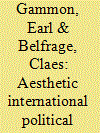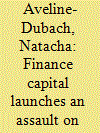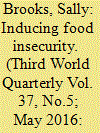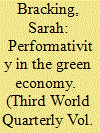|
|
|
Sort Order |
|
|
|
Items / Page
|
|
|
|
|
|
|
| Srl | Item |
| 1 |
ID:
152110


|
|
|
|
|
| Summary/Abstract |
Though aesthetics is commonly understood as the reflection on art, and especially beauty, it is a broader concern, captured by the term’s etymology in the Greek ‘aisthesis’, referring to perception and sense impressions. Aesthetics, though, is not simply a passive process, of how the outer world strikes the mind, but an interactive one, which, through our selective attention, we attenuate the complexities of reality. Aesthetics is about the formation of the objects that constitute our social milieu, those we invest in to give rhythm, order and unity to our lives. Aesthetics is also, vitally, about the formation of the self, about how we constitute ourselves as objects in relation to the world.
|
|
|
|
|
|
|
|
|
|
|
|
|
|
|
|
| 2 |
ID:
120630


|
|
|
|
|
| Publication |
2013.
|
| Summary/Abstract |
Over the past two decades, global market finance has taken root in China to seek property investment. This article examines the spatialities and anchorage methods of finance capital within Chinese national territory. It highlights the spatial and sectoral differences in the composition of property portfolios as a function of the return/risk coupling. These differences are exacerbated by a split in the geographical origin of the funds, which determines differentiated conditions of access to land and management of the investment time horizon of the assets portfolios. The penetration of finance capital into urban space tends to increase the fragmentation and functional specialisation of districts, a phenomenon fostered by entrepreneurial urban policies. As a result, urban projects are becoming standardised in terms of both design and program. They are increasingly governed by external references that favour the expansion of multinationals and transform lifestyles and consumer habits.
|
|
|
|
|
|
|
|
|
|
|
|
|
|
|
|
| 3 |
ID:
099055


|
|
|
|
|
| Publication |
2010.
|
| Summary/Abstract |
This article challenges popular claims about the capacity for microfinance to reduce poverty and empower women in the global South. Instead, I posit microfinance as a contradictory development tool, one that creates possibilities for both the contestation and continuation of unequal social relations at multiple scales. The article is divided into two major sections. I begin by examining the assumptions embedded in mainstream financial mappings of global space since the 1980s. In particular, I show how they privilege the transnational mobility of corporate capital and elide the everyday, place-based work of social reproduction. I examine the expansion and commercialisation of microfinance in this context, as an alternative mechanism for enabling poor households to continue meeting their everyday needs by taking on more debt. In the second section, I draw on fieldwork in Andhra Pradesh, India, to show how these interlocking macro/micro financial flows interact with regional social histories to shape and differentiate people's mobility 'on the ground' according gender, caste, and class. I conclude by suggesting how a critical geopolitics framework can help formulate new questions about microfinance as a development strategy.
|
|
|
|
|
|
|
|
|
|
|
|
|
|
|
|
| 4 |
ID:
144264


|
|
|
|
|
| Summary/Abstract |
The G7 ‘New Alliance for Food Security and Nutrition’ follows an established approach of ‘connecting smallholder farmers to markets’, while extending the role and influence of corporate agri-business in new ways. This paper explores the implications of the ‘New Alliance’ model’s incorporation into the Sustainable Development Goals framework for smallholder producers already facing greater uncertainty in financialised agri-food chains, and in light of a consensus around the primacy of private finance in the post-2015 era. The question for alternative food and development movements is how to confront the ‘value chain challenge’ in an increasingly financialised global agri-food system.
|
|
|
|
|
|
|
|
|
|
|
|
|
|
|
|
| 5 |
ID:
142662


|
|
|
|
|
| Summary/Abstract |
This paper asks how far performativity in the Green Economy generates material or virtual assets. It examines the relationship between assets and their financial derivatives, asking how far the value of ‘carbon’ or ‘green’ can be directly attributed to its social and narrative construction. The paper draws on two case studies – one of the Clean Development Mechanism (CDM) in South Africa, the other of the global private green bonds market – to show that both public and private climate finance can generate virtual economic activity co-produced by processes of social valuation and accumulation proper. How reliant is the Green Economy on actual economic activity?
|
|
|
|
|
|
|
|
|
|
|
|
|
|
|
|
| 6 |
ID:
128465


|
|
|
|
|
| Publication |
2014.
|
| Summary/Abstract |
Over the past decade a new form of philanthropy has emerged, termed 'philanthrocapitalism'. Champions of philanthrocapitalism suggest that private giving can fill the void left by diminished government spending on social and development programmes. Critics suggest that philanthropy is no substitute for strong governmental support for social welfare. Both arguments perpetuate a dichotomy between the public and the private, implying that philanthrocapitalism operates in a vacuum largely divorced from governmental interventions. In this article I challenge that assumption, exploring how new philanthropic initiatives have compelled increased financial support from governments toward the private sector. Drawing on three cases - advanced market commitments (amcs) in drug development; impact investing; and direct philanthropic and governmental grants to corporate entities - I illustrate the ways that governments remain one of the most powerful - if not the most powerful - philanthropic actors in the philanthrocapitalist turn.
|
|
|
|
|
|
|
|
|
|
|
|
|
|
|
|
| 7 |
ID:
111545


|
|
|
|
|
| Publication |
2012.
|
| Summary/Abstract |
This article considers the likely impact of the global crisis on the prospects for the European project. First, it considers the nature of the current crisis. It argues that it is comparable, in terms of its deep structural character, to the one in the 1930s. The crisis manifested itself first in the financial sector, but was caused by underlying problems of overaccumulation, which explains the succession of speculative booms and busts from the 1980s onward. The article then analyses how the financial crisis transmuted into the current sovereign debt crisis in Europe. It identifies a number of interdependent factors responsible for this: the bailouts of banks following the credit crisis; the stimulus programmes necessitated by the danger of a deep economic recession; the structural problems of the European Monetary Union leading to the accumulation of debt in the peripheral members; and finally the catalytic action of speculation in the financial markets. Finally, the article discusses responses to the debt crisis, outlining the contours of two alternatives (muddling through and Europeanisation), their implications, and some of the conditions for success. The conclusion is rather pessimistic: chances that an effective, timely and sustainable solution will be realised do not seem high.
|
|
|
|
|
|
|
|
|
|
|
|
|
|
|
|
|
|
|
|
|